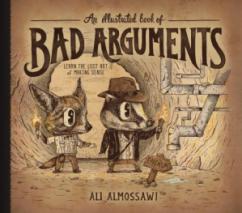 Lynn: You’d have to live in a cave in the wilderness not to know that far too many Americans have a very sketchy concept of what a fact actually is or how to verify it. The need to understand this important issue is one of national importance these days as it is clear that millions of adults don’t grasp the difference and the impact on our culture is stark. Here, with a great way to start addressing the issue, is Michael Rex with a fabulous picture book, Facts vs. Opinions vs. Robots (Penguin/Nancy Paulsen, 2020). With brightly colored cartoon-style robots, Rex’s appealing book takes on this topic with our youngest readers. The question is posed on the very first page.
Lynn: You’d have to live in a cave in the wilderness not to know that far too many Americans have a very sketchy concept of what a fact actually is or how to verify it. The need to understand this important issue is one of national importance these days as it is clear that millions of adults don’t grasp the difference and the impact on our culture is stark. Here, with a great way to start addressing the issue, is Michael Rex with a fabulous picture book, Facts vs. Opinions vs. Robots (Penguin/Nancy Paulsen, 2020). With brightly colored cartoon-style robots, Rex’s appealing book takes on this topic with our youngest readers. The question is posed on the very first page.
“Do you know the difference between a fact and an opinion?
It can be a hard thing to understand. Even these robots get confused.
But maybe if we work together, we can figure it out.”
Taking it step by step, the robots define the two concepts and then provide simple examples to practice. The examples are engaging and child-centered with plenty of humor. The robots are goofy but Rex does a wonderful job of presenting the information in a clear, understandable, and appealing way. Kids are going to WANT to read this book all the way through thanks to the level of humor but more importantly, they are going to grasp and remember this idea. The story also includes the concept of needing to search for more information sometimes and also reminds readers that while we need to respect other people’s opinions, we can’t argue with facts.
If I could, I’d buy this book for every classroom and library in America!
Cindy: What a great way to introduce an important skill in information literacy. Elementary librarians, take note! What if you read this book aloud and then had your students write a declarative sentence and have them present it for the other students to respond with Fact or Opinion? This could work in a virtual class meeting as well. Students could make a 2-sided notecard with the FACT on one side and OPINION on the other and hold them up to their cameras. Lots of ways to use this in an elementary classroom as well.
 This book for the very young audience brings to mind a book for older students that we reviewed over at Booklist Reader during the last presidential election cycle and it’s worth mentioning again as the facts, opinions, and faulty logic arguments ratchet up. Read our blog post about Bad Arguments: Learning the Lost Art of Making Sense (The Experiment, 2014) by Ali Almossawi if you missed it the first time around. It’s a good time to separate facts from opinions and to do it without faulty logic.
This book for the very young audience brings to mind a book for older students that we reviewed over at Booklist Reader during the last presidential election cycle and it’s worth mentioning again as the facts, opinions, and faulty logic arguments ratchet up. Read our blog post about Bad Arguments: Learning the Lost Art of Making Sense (The Experiment, 2014) by Ali Almossawi if you missed it the first time around. It’s a good time to separate facts from opinions and to do it without faulty logic.


